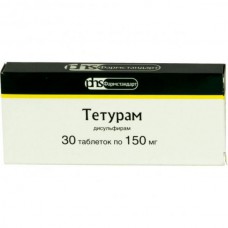Expiration date: 07/2025
Active substance: Disulfiram
Characteristics
White poor yellowish greenish white crystalline powder. It is soluble in alcohol, practically insoluble in water, acids and alkalis. The molecular weight of 296.54.
Pharmacology
Mode of action - antialcoholic.
It inhibits the enzyme acetaldehyde dehydrogenase and inhibits the biotransformation of alcohol at the acetaldehyde stage. The accumulation of the latter in the body causes intoxication, which (because consciousness is stored) is accompanied by a heavy feeling.
Once inside quickly and completely (70-90%) is absorbed in the digestive tract. Enough is metabolized rapidly, recovering to dietilditiokarbonata excreted by the kidneys as glucuronide or decomposes to form carbon disulfide and diethylamine, part of which (4-53%) is output from the light.
Application
Treatment and prevention of relapse of chronic alcoholism; nickel chronic intoxication.
Contraindications
Hypersensitivity, thyrotoxicosis, diseases of the cardiovascular system in the stage of decompensation (including a pronounced cardio, atherosclerosis of brain vessels, pre- and postinfarction state, aortic aneurysm, coronary insufficiency, hypertension II-III century., Chronic heart failure) , severe diseases of hearing (cochlear neuritis) and the eye (glaucoma, optic neuritis); diabetes, pulmonary tuberculosis with hemoptysis, bronchial asthma, severe emphysema, exacerbation of peptic ulcer disease, severe liver failure, kidney disease, cancers, diseases of blood-forming organs, mental illness, epilepsy and convulsions of any origin, polyneuritis, pregnancy, breastfeeding.
Restrictions apply
Cardiovascular diseases in the compensation stage, gastric ulcer and duodenal ulcer (in remission), residual effects after cerebrovascular accident, endarteriit previously transferred psychoses while taking disulfiram, age older than 60 years.
Pregnancy and breast-feeding
Category effects on the fetus by FDA - C.
Side effects
Conditional properties of disulfiram: a metallic taste in the mouth, bad breath in patients with colostomy (associated with sulphide of carbon), and rare cases of hepatitis (similar sometimes observed in patients with nickel eczema, not alcoholics), polyneuritis of lower limbs, optic neuritis, memory loss, confusion, fatigue, headache, allergic skin manifestations.
Related to the combination of disulfiram-ethanol: describes cases of respiratory failure, cardiovascular collapse, cardiac arrhythmias; angina, sometimes - myocardial infarction, as well as neurological disorders; cerebral edema, depression of consciousness up to coma.
Upon receipt of alcohol in excess of 50-80 ml of vodka, while taking disulfiram may develop severe disorders of the cardiovascular and respiratory systems, swelling, convulsions (necessary to carry out detoxification therapy, the introduction of analeptikov, symptomatic therapy).
Complications of chronic administration: rare - psychosis, resembling alcoholic; hepatitis, gastritis; in patients suffering from cardiovascular disease, thrombosis, cerebral vascular possible, so the complaints of paresthesia of the limbs and facial area should stop the drug immediately; exacerbation of polyneuritis.
Interaction
The reaction in ethanol reduces ascorbic acid.
Contraindicated combinations
Alcohol: hypersensitive reaction (flushing, erythema, vomiting, tachycardia). simultaneous reception of alcoholic beverages and drugs containing alcohol should be avoided.
Undesirable combinations
Isoniazid: breach of conduct and co-ordination.
Nitro-5-imidazole (metronidazole, ornidazole, seknidazol, tinidazole): delirious disorder, confusion.
Phenytoin: a significant and rapid rise in the level of phenytoin plasma with toxic symptoms (suppression of its metabolism). If the combination can not be avoided, it is necessary to conduct the clinical observation and monitoring of plasma concentrations during and after treatment with disulfiram.
Combinations requiring caution
Warfarin (or other oral anticoagulants): increased effect of oral anticoagulants and risk of bleeding (decreased metabolism of warfarin in the liver). It is recommended more frequent monitoring of warfarin concentration and dose adjustment of anticoagulants during disulfiram purpose and within 8 days after its cancellation.
Theophylline: Disulfiram inhibits the metabolism of theophylline, the theophylline dose should therefore be adjusted (reduced dose), depending on the clinical symptoms and the drug concentration in plasma.
Benzodiazepines: disulfiram may potentiate the sedative effects of benzodiazepines by inhibiting their oxidative metabolism (especially chlordiazepoxide and diazepam). Benzodiazepine dosage should be adjusted according to the clinical manifestations.
Tricyclic antidepressants: may increase the reaction of alcohol intolerance (disulfiram reaction - ethyl alcohol).
Overdose
Symptoms: coma, collapse, various neurological phenomenon.
Treatment: symptomatic.
Dosing and Administration
Inside, in / m and n / a. Inside, the dose is adjusted individually, is usually 0.25-0.5 g / day; Treatment begins after a thorough examination of the patient and the prevention of the consequences and complications. P / and / m are implanted on Table 8-10.
Precautions
Patients should be warned of the dangers of intolerance responses of alcoholic beverages. In the case of co-administration with oral anticoagulants is necessary to carry out more frequent monitoring of prothrombin content and correction doses of anticoagulants, which is associated with an increased risk of bleeding.
It should be used with caution in patients with renal insufficiency, or hypothyroidism, especially when the risk of a possible combination with alcohol.



